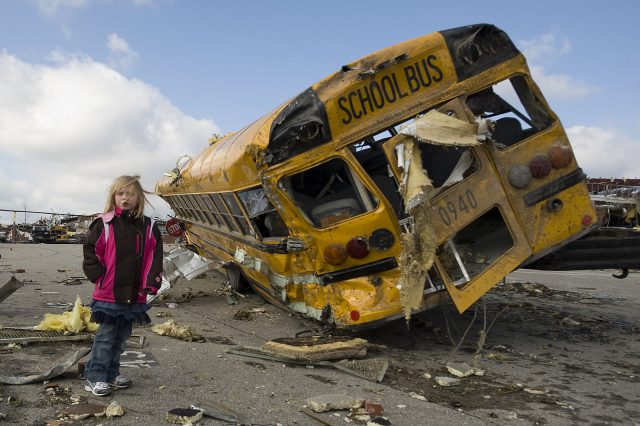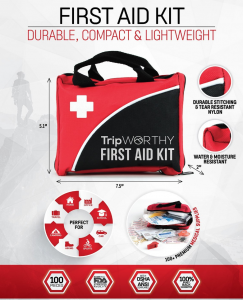A tornado warning has been issued. What do you do? One is actually heading your way. Now what do you do?
The top 10 tornado safety steps you must take to stay alive are below, followed by the difference between a tornado warning vs watch, the top 10 tornado signs to beware of, exactly when and where they are most likely to happen, and other crucial info.
There will be about 1200 tornadoes in the US this year. They will kill or injure over 1500 people. Because your knowledge about tornado dangers and your preparedness can be the key difference between life and death for you and your loved ones, what follows is vital information.
Who else do you know that could benefit from these facts? Please SHARE this page with them — they will be thankful because it just might save their life, too!
Top 10 Tornado Safety Tips
- Get far from windows and large and small objects that can become deadly projectiles.
- Get far away from gas pipes, appliances that use gas, and electrical poles and wires.
- Decide now where you and your family will seek shelter, at home, work, or school.
- The lowest level of buildings away from windows, exterior walls, and gas are safest.
- Crouch face-down, knees tucked under your chest and hands atop your head.
- Get under something sturdy, like a solid table, for more protection.
- If thick blankets or coats are immediately available, cover your head and body.
- Cars and mobile homes are top tornado dangers. Leave immediately for safer shelter.
- If you’re outside, head to low ground like a ditch, away from vehicles, trees and poles.
- As soon as you hear tornado warning, seek shelter. Any delays can cost you your life.
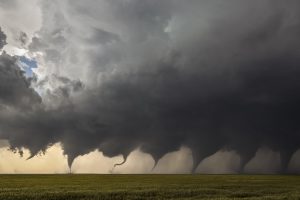
Tornado Warning vs. Watch
What is a tornado warning versus watch?
A watch means the conditions are favorable for a tornado to develop. It does not mean a tornado has actually developed, but you should stay tuned in case one does.
A tornado warning means either one has been spotted in your area or low level rotation that can suddenly turn into one has been spotted, and you should seek shelter.
We Hope You Find This Tornado Info Helpful.
Afterward, DO NOT Miss Our Important New Report:
Protect Yourself.
Protect Your Children.
What are the actual top 10 threats to
you and your loved ones if you
live in the USA? We did the research.
The answers will surprise you.
Please DO NOT miss this brand new report,
The Top Threats to Your Life, Health, and Sanity in 2018.
“No hype, no fear-mongering… This info truly can save and improve lives!”
Enter Your Email Below, Because It’s Yours FREE Instantly Today:
Tornado Preparedness – 5 Essentials
Preparedness makes a monumental difference in staying safe during a tornado. The smartest time is right now to plan and prepare.
- Know exactly where you will take shelter from a tornado well in advance in your home, workplace, school, and other buildings you spend frequent time in.
- Practice a tornado drill with everyone in your home at least once a year, twice yearly if tornado dangers are high in your area.
- Make sure you and your loved ones know the best options for tornado safety if you are in a car, outside, or in building you don’t frequent often during a tornado warning.
- Be sure to create a tornado kit consisting of essential supplies in case of a tornado or other disaster, and locate it in your shelter area. Your disaster kit should at least include:
- Heavy blankets and/or coats to protect during a tornado (and keep you warm after)
- Bike helmets to protect heads
- Water – ideally one gallon per person per day for 3 days
- Food – 3-day-plus supply of non-perishables like nuts, jerky, raisins, canned goods
- Hand-crank radio w/ NOAA weather alerts and SOS alarm. See top-recommended.
- Flashlights
- Extra batteries
- Garbage bags, moist towelettes, sealable plastic bottles/buckets for sanitation.
- First aid kit. See top-recommended.
- Surgical or dust masks
- Can-opener
- Cell phone with backup charger
- Multipurpose tool. See top-recommended.
- Wrench to shut utilities off
- Backup essentials if you have babies, medical conditions/special needs, pets
- Copies of crucial documents (e.g., medications, emergency contacts, insurance info)
- Keep a second tornado kit consisting of at least the most essential of the emergency supplies above in your car, including for if you’re stranded and for other disasters.
The 10 Tornado Signs
Because tornadoes can happen so quickly, do not depend solely on National Weather Service warnings. Know the tornado signs to watch for including:
- Debris falling from the sky, because sometimes you can’t even see a tornado.
- An approaching wall or cloud of debris, because tornadoes sometimes have no funnel.
- A continuous rumbling sound like a freight train that does not fade out like thunder.
- A dark, often greenish sky.
- Heavy rain or hail, after which the winds stop and the air goes dead calm.
- Heavy rain or hail, after which the winds suddenly and intensely switch direction.
- Large hail, such as mothball- or even golfball-sized.
- A funnel-shaped cloud extending from dark clouds toward the ground.
- The bottom of a cloud base is rotating versus floating.
- At night, blue-green to white flashes at ground level may be a tornado snapping power lines.
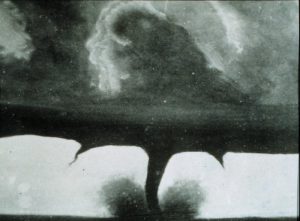
What to Do In a Tornado Warning
- The moment you hear a tornado warning, gather your loved ones and take shelter.
- Do not delay to check the TV or try to see the tornado — this can cost you your life.
- Head to the basement, cellar, or lowest area of the building without windows.
- Try to get under sturdy furniture, like a solid table.
- Put helmets on if available, cover with heavy blankets or coats if available.
- Crouch low to the floor or ground, facing down, and cover your head with your hands.
- If you’re in a vehicle or mobile home, leave it immediately and seek safe shelter.
- If no other options, seek shelter in a ditch away from cars, trees and power lines.
- Don’t try outrunning a tornado in your car.
- Don’t seek shelter under bridges, they are unsafe.
- Remind yourself and loved ones to stay calm. Take slow deep breaths to help.
- Stay in your safe area for several minutes after the tornado warning has concluded.
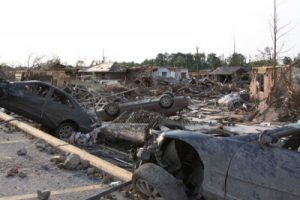
What to Do in a Tornado
Remember it is the flying debris getting flung out of tornadoes that kills and injures by far the most people. Even tiny objects become dangerous projectiles at such high speeds.
 Therefore, in a tornado stay crouched as low to the ground as possible, knees tucked under your chest and hands covering your head to protect your vital areas as much as possible. Try to take long deep breaths to remain as calm as possible.
Therefore, in a tornado stay crouched as low to the ground as possible, knees tucked under your chest and hands covering your head to protect your vital areas as much as possible. Try to take long deep breaths to remain as calm as possible.
Do not leave this position until well after the tornado has passed, because debris getting flung from tornadoes can travel quite far.
What Should You Really
Worry About This Year?
There’s a LOT of fear-mongering out there. Most is untrue. We scoured the data. These are the actual top 10
threats to your life and quality of life
every American needs to know.
No scare-tactics. No hype. Just the crucial facts.
The Annual U.S. Report from YouDefense.com. Yours Free Right Now:
What to Do After a Tornado
- Leave the building or area immediately if there is fire or rising flood water.
- Leave immediately if you smell gas or chemicals, or downed power lines are near.
- If you’re trapped, call 911 if you can. Make noise with an alarm, whistle, your voice, etc.
- Do not move anyone seriously injured unless they’re in immediate danger. Call for help.
- Provide first aid to others as needed.
- If your home has been damaged, get everyone out as soon as possible.
- If your home has not been damaged, shut off all gas and electric power sources.
- If your home has not been damaged, keep kids and pets inside, away from dangers.
- Turn on the radio or TV for emergency info, including other possible tornado warnings.
- Notify officials as soon as possible of those needing help and dangers like leaking gas.
- Stay out of other damaged buildings and dangerous areas.
- Take photos of damage to your house and goods for insurance.
Where Do Tornadoes Happen
- Tornadoes have happened on every continent except Antarctica.
- Tornadoes happen the most in the United States versus any other country.
- Every US state has had at least one reported tornado.
- The 5 states with the most tornadoes are Texas, Kansas, Oklahoma, Florida, Illinois.
- The next 5 states are Colorado, Iowa, Alabama, Missouri, Mississippi.
- The most tornadoes per square mile happens in Oklahoma.
- Alabama has had the most of the strongest EF-5 tornadoes since 1950, 9 total.
- Arkansas has had 27 of the second strongest EF-4 tornadoes since 1950.
- Alaska is the state you are least likely to experience a tornado.
- The great majority of tornadoes in the US happen east of the Rocky Mountains.
- Tornadoes happen in cities, suburbs, and rural areas – they don’t discriminate.
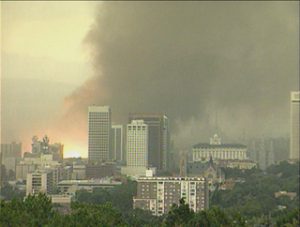
When Do Tornadoes Happen
- Tornadoes happen anytime day or night, in any month.
- They are most likely to occur between 3 p.m. and 9 p.m.
- Tornadoes happen the most in May in the US, with an average of 269.
- Next is June with 229, April with 178, July with 123, and March and August with 75.
- Tornadoes happen the least in December, with an average of 27.
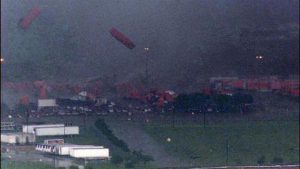
Tornado Facts
- The whirling winds of tornadoes can exceed speeds of 300 miles per hour.
- Tornadoes can last several seconds to over an hour. Most don’t exceed 10 minutes.
- The width of a tornado path ranges from 100 yards to 2.6 miles.
- Tornado damage paths can be up to 50 miles long.
- Most tornadoes travel from the southwest to northeast.
- Tornadoes can travel from 10 mph to 73 mph, with an average speed of 30 mph.
- One key tornado danger is they can change paths suddenly and erratically.
- The difference between a tornado and a funnel cloud? Funnel clouds don’t touch earth.
- The Enhanced Fujita Scale ranks tornadoes based on wind speeds, from EF-0 to EF-5.
- EF-0 tornado wind speeds are 65-85 mph. EF-5 tornado wind speeds are 200 mph+.
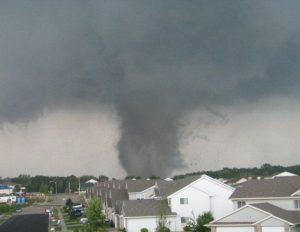
Tornado Myths
There are multiple common myths about tornadoes that are not true, and could cost you and your loved ones your life. Here are the top 5:
Myth #1: If you’re in your car or outside, try to take shelter under a bridge or overpass.
Fact: Winds escalate under bridges and overpasses, escalating the dangers.
Myth #2: Open your windows if a tornado is approaching to reduce danger and damage.
Fact: Damage is caused by high winds and flying objects. This just wastes precious time.
Myth #3: The southwest corner of a basement is the safest place to be.
Fact: The safest place is the lowest level, away from glass, exterior walls, and gas.
Myth #4: If you live by mountains, tall buildings, in valleys, or near water you are safe.
Fact: Tornadoes travel anywhere, including up and down mountainsides and on water.
Myth #5: You can always see a tornado.
Fact: Some tornadoes are basically invisible, hidden within heavy rainfall or darkness.
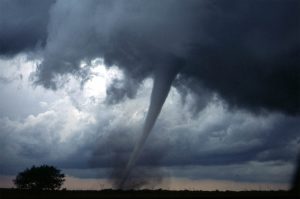
When it comes to tornado safety, you are now more aware than most people.
Be sure to save this page and review this information periodically, including what to do in a tornado warning. And remember that the best time to take the steps outlined in the Tornado Preparedness section is right now.
Sources
American Red Cross
Centers for Disease Control and Prevention
Department of Homeland Security
National Weather Service
Occupational Safety and Health Administration
Texas Tech University
US Tornadoes
The Weather Channel
PLEASE SHARE ↓↓↓ THIS PAGE with everyone you know — awareness is the first key, and this tornado safety information truly can save their lives!

